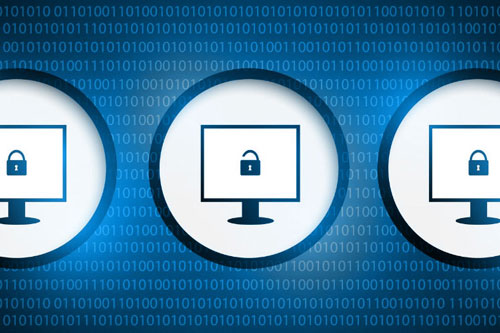You’re accessing archived content
This is archived content from the UIT website. Information may be outdated, and links may no longer function. Please contact stratcomm@it.utah.edu if you have any questions about archived content.
It’s a trap! Why so many phishing attacks succeed.
Phishing is one of the most common cyberattacks against higher education institutions and their students, faculty, and staff — and one reason for recent UMail and Microsoft Office 365 security upgrades at the University of Utah.
Phishing attacks can take many forms, but they all share a common goal — getting you to share sensitive information, such as login credentials, credit card information, or other restricted and/or sensitive data. Although the U maintains controls to help protect our networks and computers from cyberthreats, we rely on you to be our first line of defense.
Here’s how you can do your part and be cyber smart.
Master manipulators
Criminals use phishing attacks to try to trick you. They will impersonate people, departments, organizations, and even the university to obtain your uNID and password, or other restricted/sensitive information. Phishing emails are designed to provoke an urgent and emotional response.
Look for subject lines like:
- Update your Healthcare Information ASAP
- Please Read Important from …
- Urgent Request
- COVID-19 Information. Family member has tested positive.
- Account update
- Mail Synching Error
- Review important tax summary before end of day.
- Office 365 Incoming mail on hold
- Congratulations! You have won …
- Fwd: confirmation of payment
- Delivered item was stolen
- Your mailbox storage is running out. Click here to increase the size
If the subject line doesn’t seem suspicious, but you aren’t familiar with the sender, you notice poor spelling and/or grammar, or unknown links, it still might be a phishing attempt. Keep your emotions in check and do not be manipulated. Think before you click.
You also might receive emails that appear to come from file-sharing sites like UBox, Dropbox, Google Drive, or OneDrive alerting you that someone has shared a document with you. The links provided in these emails will take you to fake login pages that mimic real ones and will steal your account credentials.
How to protect yourself
To avoid phishing schemes, please observe the following email best practices:
- Be wary of emails that provoke an urgent and emotional response.
- Do not click on links or attachments from senders you do not recognize. Be especially wary of .zip files, or other compressed or executable file types.
- Do not provide sensitive personal information (e.g., usernames and passwords) over email, ever.
- Watch for email senders who use suspicious or misleading domain names.
- Inspect URLs carefully to ensure they’re legitimate and not imposter sites.
- Do not open any shared document that you did not expect to receive.
- Be especially cautious when opening attachments or clicking links if you receive an email containing a warning banner indicating that it originated from an external source.
- Slow down and pay attention as you review your inbox. It takes only one phishing email to compromise your system and spread to others in the organization. Consider adding two-factor authentication (2FA) to your email accounts in order to verify any login attempts.
A middle-aged white man (who we will call the "fisher" from now on) wearing a green fishing vest with many pockets walks through a grove of trees, holding a fishing pole and tackle box. He has short, light brown hair and scruffy facial hair, and wears a red, white, and blue flannel shirt and jeans. He sets the pole and tackle box on the ground and stretches his arms above his head. White text flies up, reading "phish•ing." More white text follows, reading:
"phish•ing /fi-SHiNG/"
"noun"
"Tricking a user into sharing personal information or login credentials by posing as an official source."
0:09: The video transitions to the fisher sitting at a desk with two computer monitors. The monitor on the left shows a document containing a pie chart; the monitor on the right shows a yacht on water. The man rubs his hands together and cracks his knuckles, then begins to type on his keyboard. Near his keyboard, under the monitors, he has Funko Pop statues and comic book figurines.
0:13: The video transitions back to the fisher in the grove of trees. The video zooms in on the fisher's hands; he holds a small, metal box containing fishing lures. He selects a lure and attaches it to his fishing line. He then walks toward a red block U statue on the University of Utah campus.
0:23: The video moves to a shared work table, where a man and woman huddle over their Apple laptops. The white man has dark, short hair and wears a light-colored button-up shirt and khaki pants; the white woman has long, dark, wavy hair and wears a black dress. She holds a dark folder open in her lap. A woman sits adjacent to them, wearing headphones and using her Apple laptop. She has dark hair pulled into a bun and wears dark glasses and a light-colored hoodie.
0:25: The video transitions back to the fisher, who stands in front of the "Imagine U" side of Marriott Library, casting his fishing line toward the building. He walks through campus again, passing a set of stairs and multiple street lamps. He then casts his line toward a white female student passing by on the sidewalk, which is lined with trees full of leaves. The red block U is behind him on the left. The student — who is wearing a multicolored, short-sleeved shirt with chevron patterns, black pants, and a backpack — shies away.
0:35: The fisher continues casting his line in various places around campus. In one scene, he even pops out beyond a bush to startle a man passing by. The white man is wearing a blue button-down shirt with the sleeves rolled up and jeans. In another scene, the fisher casts his line toward a white male man who is walking his bike on the sidewalk. The cyclist has long light brown or blond hair, and wears red flannel, dark jeans, a red and white hat, and a backpack and carries a light-colored helmet. He ducks from the fishing line.
0:41: In the next scene, the fisher climbs a rock and looks out over the landscape. He then appears to reel in his fishing line, which is taut. Text fades in from the left, reading "You will never receive a threatening or intimidating email from any legitimate University source."
0:48: The video transitions to a man, whose face we cannot see, typing on a black laptop with a U drum and feather sticker and a white sticker in the shape of Alaska. He is wearing a white shirt with a dark graphic, Apple headphones, and a red and white braided bracelet. On the desk, there is a couple of notebooks, and red and blue pens. Light filters in behind him. Text fades in from the left, reading "Never share your uNID and password with anyone."
0:53: The video transitions to a black screen that shows icons and text on the common signs of phishing scams, including the "no" symbol and a tip that reads: "Common Phishing Scams." A pointer moves to reveal the following bullet points:
- "Unusual email language, poor spelling or grammar"
- "The URL doesn't match webpage"
1:02: The video then moves to into an example of a webpage in the Safari browser. The URL reads "www.TAKEALLYOURMONEYANDRUN.org," and the page imitates a University of Utah login screen. A browser tab in the background reads, "Funny Cats — YouTube." The video zooms in on the URL, which is highlighted with a white overlay while the rest of the screen is darkened by a black overlay.
1:05: The video returns to the bullet point list of common phishing scams. The next item reads, "When hovering over link, it doesn't match the promised content."
1:08: The screen transitions to an email client, which shows an example of an email. Highlighted is a link that reads, "here" but shows a URL to "http://takeallyourmoneyandrun.org."
1:11: The video transitions into a library, where an Asian man sits at a desk with his hands on the keyboard of the laptop open in front of him. He is wearing a checkered button-down shirt with the sleeves pushed up and a pair of glasses. His hair is black and a bit long around the ears, forehead, and back of the neck. A backpack or messenger bag is on the table next to his laptop, and a chair is open to his left. In the background, light filters in from large windows and two stacks/shelves hold numerous books.
1:15: The video zooms in on the Asian man and his laptop. On the screen, text reads "Guard your uNID and password like your Social Security number." Then video transitions into a montage of shots of people using open laptops. The first image shows a desk with an open laptop, which has multiple windows open. White hands barely touch the edge of the keyboard. Text fades in that reads "Change your password often." The second image shows a white man using the touch pad on his laptop to scroll. We only see his hands and the sleeves of his button-down shirt, which is white checkered with dark lines. The third image shows a white woman using a silver laptop. She faces us so we cannot see what is on the screen. She has long, brown hair and wears a dark T-shirt. To her right, another white person, who appears to be a woman, types on a laptop. This person is wearing a gray sweatshirt or hoodie. Text fades in that reads "Change your password and call the Campus Help Desk immediately." A phone number reading "801-581-4000" fades in.
1:25: The video transitions back to an outdoor space on campus with grass and trees. A man in a light blue-green shirt and dark pants walks left past our view. Another man, somewhat balding, walks right past our view. He wears a dark blue or black shirt with short sleeves and a collar, and jeans. The fisher is in the background, waving his fishing line.
1:29: The video returns to the fisher's desk, with a close-up on the Funko pop and comic book figurines. The figurines include Superman and a shark, but it's not clear which characters the others represent. The video zooms out so we can see the fisher sitting at the desk. He makes a fist with his right hand and pulls it downward in a motion that represents cha-ching, yes, score, gotcha, or a similar celebration. He throws his head back and laughs.
1:32: The screen goes black. The University Information Technology (UIT) logo (white text with a red Block U) and white text reading "it.utah.edu/" fade in, with the word "security" added shortly after to the end of the URL so it reads "it.utah.edu/security."
1:37: The screen changes to a white background with a gray gradient at the bottom that shows a mirror image of the red and black Imagine U logo in the center of the screen.
Phishing is becoming more and more popular.
We're talking about phishing with a "ph." Not the river-runs-through-it kind.
It's about cyber scammers, con artists, and thieves. Every day they're baiting and hooking personal information and gutting bank accounts. It's happening all around the nation and right here at the U.
Faculty, staff, and students are all vulnerable, and attacks are becoming more targeted.
Because some university personal information is readily available, scammers are often using it, along with emotional responses, to get you to act.
It's important to stay vigilant and know thieves are trying to land the big one.
You will never receive a threatening or intimidating email from any legitimate university source.
Don't take the bait. Never share your uNID and password with anyone. And look for the signs that are common in phishing scams. Things like:
- unusual email language or spelling or grammar
- the URL doesn't match the webpage
- when hovering over a link, it doesn't match the promised content
Here's what to do to stay protected:
- Guard your uNID and password like your Social Security number
- Change your passwords often
- Lock your screens when not in use or when you leave your desk
If you've been hooked, call the Campus Help Desk (801-581-4000, option 1) immediately.
Trust your gut. If it smells fishy, it probably is.
For more information, visit it.utah.edu.
If you receive a phishing email …
When you receive a phishing attempt through a university email account, the Information Security Office (ISO) asks that you immediately report it. The ISO can then confirm the phishing attempt, remove the email, and block the sender from our system to protect other students, faculty, staff, patients, and community members.
- Forward the email as an attachment to phish@utah.edu.
- If you are unsure how to forward a message as an attachment, use a search engine to find instructions for your email client or ask someone to assist you.
- If using UMail via Outlook Web Access (OWA), compose a new message, then drag and drop the email you want to forward into the body of the new message to send it as an attachment. Access this vendor support website for more information.
- If, by accident, you click on a questionable link and enter login credentials, immediately go to the Campus Information Services portal (https://cis.utah.edu/) and change your password. In addition, contact ISO's Security Operations Center at soc@utah.edu to notify information security staff.
If you need additional assistance, please contact your cognizant central IT help desk:
- Main Campus UIT Help Desk: 801-581-4000, option 1
- University of Utah Health ITS Service Desk: 801-587-6000
Report a scam
To make a police report regarding a scam, call the University of Utah Police at 801-585-2677 and ask to speak with an officer. This request will create a call log, which will show the date, time, and nature of your complaint. After speaking with an officer, you will receive instructions on next steps.
2020 Cybersecurity Awareness Month
 Creating a cybersecure workspace — at home
Creating a cybersecure workspace — at home
 Meet the computer forensics experts who investigate the U's cybersecurity incidents
Meet the computer forensics experts who investigate the U's cybersecurity incidents
 What to do when an abuser uses technology against you
What to do when an abuser uses technology against you
 8 simple tips to improve your online safety and security
8 simple tips to improve your online safety and security
 Common scams — and how to spot them
Common scams — and how to spot them
 CSAM Scavenger Hunt
CSAM Scavenger Hunt
